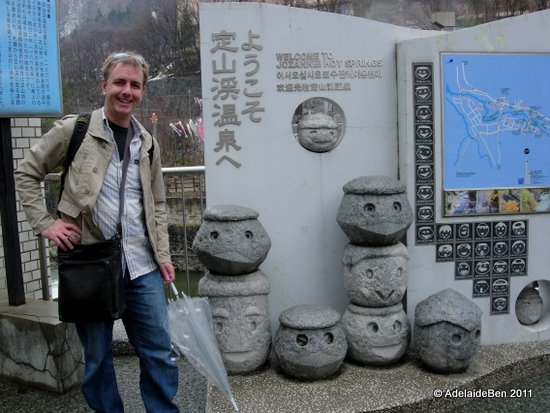15th April, 2009 - It was a somewhat lazy start to the day after our night of... well... eating orgy. Needless to say, T-chan and I managed to have a relaxing morning ... but not much of a sleep-in as it was off to the onsen for an early bath followed by a quick tour of the immediate area. The hotel shuttle bus would be arriving (too) early to allow for a real sight-seeing adventure. For those that are interested in visiting, the Jozankei site can be found here.
Whilst the hot-springs are why people come to Jozankei, there's plenty of stuff to do... in Autumn you can pop down to Houhaikyou Dam to see some brilliant scenery, and in winter you can ski. Autumn alas is another 6 months away, so we'd just have to make do with the small things, like the koinobori suspended over the river.
Now if you are wondering what all the koinobori streamers are for... well, they're more like pennants than anything. The name koinobori comes from koi (鯉) being carp, and nobori (幟) meaning banner. These are the traditional decoration that is put up for Children's Day (kodomo no hi) which occurs on the 5th May each year... and which is one of the public holidays that makes up Golden Week. Actually the festival originated in ancient times (from before the Heian Period) as the lunar festival Tango no Sekku. This was one of five seasonal festivals, and the one associated with the start of the summer rainy season... though the seasons are quite different here in Hokkaido it was still quite wet (but for different reasons).
The festival became associated with the celebration of boys, and indeed is often still referred to as the Boy's Festival... One of the aspects of the Boys Festival is that koinobori would be hung outside of the family house. The number and size of koinobori was dependent on the number of sons in the house (the biggest koinobori belonging to the eldest son). The significance of the Carp comes from an old Chinese legend that tells that if carp can make it to the top of a certain river (in China) they can become a dragon. The koinobori is therefore a symbol of the parents wish that the sons will endure and persist hardships to go on to great things.

Somehow in post-war Japan the Boys Festival was modified to be gender-non-specific. Was this an attempt to soften the Japanese culture, or to rebalance the gender bias? Strangely girls still have their Girl's Festival on 3rd March... And the name doesn't much matter anyhow as the trappings of the boys festival (koinobori and the samurai helmet displays known as kabuto) are still going strong in Japan.
Now for those that have read my other blog, you might recognise the chap below... it's a Kappa, the mischevious spirit that are said to inhabit just such areas as this. And like many parts of Japan, there are statues and art memorializing the little fella. Jozankei is said to be one of the places were you can find Kappa... or be found by them... so they have even more statues than normal.
In fact, they REALLY like Kappa statues here...they are all over Jozankei. As you can see by the nonchalantly held umbrella.... it was a slightly damp morning... whilst it may not have been the best weather for carp-flying, it was however perfect weather for an industrious Kappa-folk to come visiting. And still I have yet to see my first live kappa! ?;-)

Now we didn't have much of a chance to have a deeper look around, but there was one place I was curious to see... Iwanto Kannondo (otherwise known incorrectly as Jozankei Jinja, or shrine). Now this unimposing shrine hides a great little secret.
 |
| Care of Google StreetView |
Inside the small building you'll find a doorway (on the right) that leads you through to an underground tunnel that cuts 120 metres into the mountainside before ending up opening up on the other side. It actually it looks more like a service tunnel than a cave (as it's often described). Entrance to the tunnel is by donation... so be honest and drop a coin or two in the collection tray.

Along the tunnel you will find a number of alcoves, and inside each of the alcoves you'll find a statue of the Kannon; ranging from the slightly gaudy to the more honest and rustic rough cut stone statues. Actually there's 33 statues of the Kannon to be exact. Kannon is the Japanese form of Guānyīn, who is also known as the Goddess of Mercy. Now... that means that this is not a "shinto shrine" at all, but rather a place of Buddhist veneration. I have read somewhere that this site was built for the many workers that were killed making tunnels in the local area. I would have thought it somewhat tempting fate then to build another tunnel to house these statues...
It makes for an interesting, if slightly unnerving 5-10 min diversion whilst you're waiting for the bus. Just a word of advice however - being inside a tunnel 100 metres under a mountain is not a great place to hear a bus approaching. Make sure you leave plenty of time, just in case. Also - don't be surprised to get a little bit wet as there's often water running down from the ceiling of the tunnel (that's the unnerving part).
And speaking of water, if you've got the time and inclination, you can always try out the inumerous hand and feet baths that can be found around the area. They're free to use, and might ease some aching bones from walking through the mountains (especially if you up to see autumn colours).
With that we say farewell to Jozankei for now. I'm sure we'll be back!






No comments:
Post a Comment